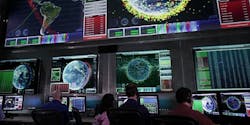Air Force chooses Lockheed Martin to design and build Space Fence radar to track space junk
Officials of the U.S. Air Force Life Cycle Management Center at Hanscom Air Force Base, Mass., announced a $914.7 million contract Monday to the Lockheed Martin Mission Systems and Training segment in Moorestown, N.J., to build the Space Fence, which will be a space-tracking radar system on Kwajalein Atoll in the Northern Pacific roughly between Hawaii and Australia.
The Space Fence will be a large S-band radar on Kwajalein near the equator, which offers a wide angle for the radar to track as much of Earth's equatorial space orbits as possible. These orbits are the most densely populated with spacecraft and space junk.
The Space Fence radar should be able to see at least 200,000 orbiting objects -- some as small as baseballs. Tracking these orbiting objects will help Air Force experts warn satellite and manned spacecraft operators to move their assets out of the way before possible collisions. Experts say at least half a billion objects are orbiting the Earth.
The Space Fence radar that Lockheed Martin will build is set to replace the Air Force Space Surveillance System, which was taken offline last year due to Pentagon budget cuts. The Lockheed Martin Space Fence should be able to track twice the amount of orbiting space junk with finer resolution than the Space Surveillance System.
The contract awarded to Lockheed Martin on Monday gives the company until fall of 2018 to bring the new Space Fence radar system online in an initial operational capability status. The contract is for Space Fence engineering, manufacturing and development, production, and deployment.
Related: Boeing upgrades advanced electro-optical system for space surveillance
Once the system is operational, data Data from the Space Fence will feed into the Joint Space Operations Center, which is responsible for space surveillance, collision avoidance, and launch support. Analysts will use large databases to predict the tracks of debris, and when they might come close enough to hit valuable objects in space.
The Space Fence radar will be able to track more and much smaller pieces of debris than the system it replaces. Space junk can travel as quickly as 17,000 miles per hour, which NASA officials say would give an object just a half-inch around the kinetic power of a bowling ball traveling at 300 miles per hour.
For more information contact Lockheed Martin Mission Systems and Training online at www.lockheedmartin.com/us/mst, or the Air Force Lifecycle Management Center at www.wpafb.af.mil/aflcmc.
